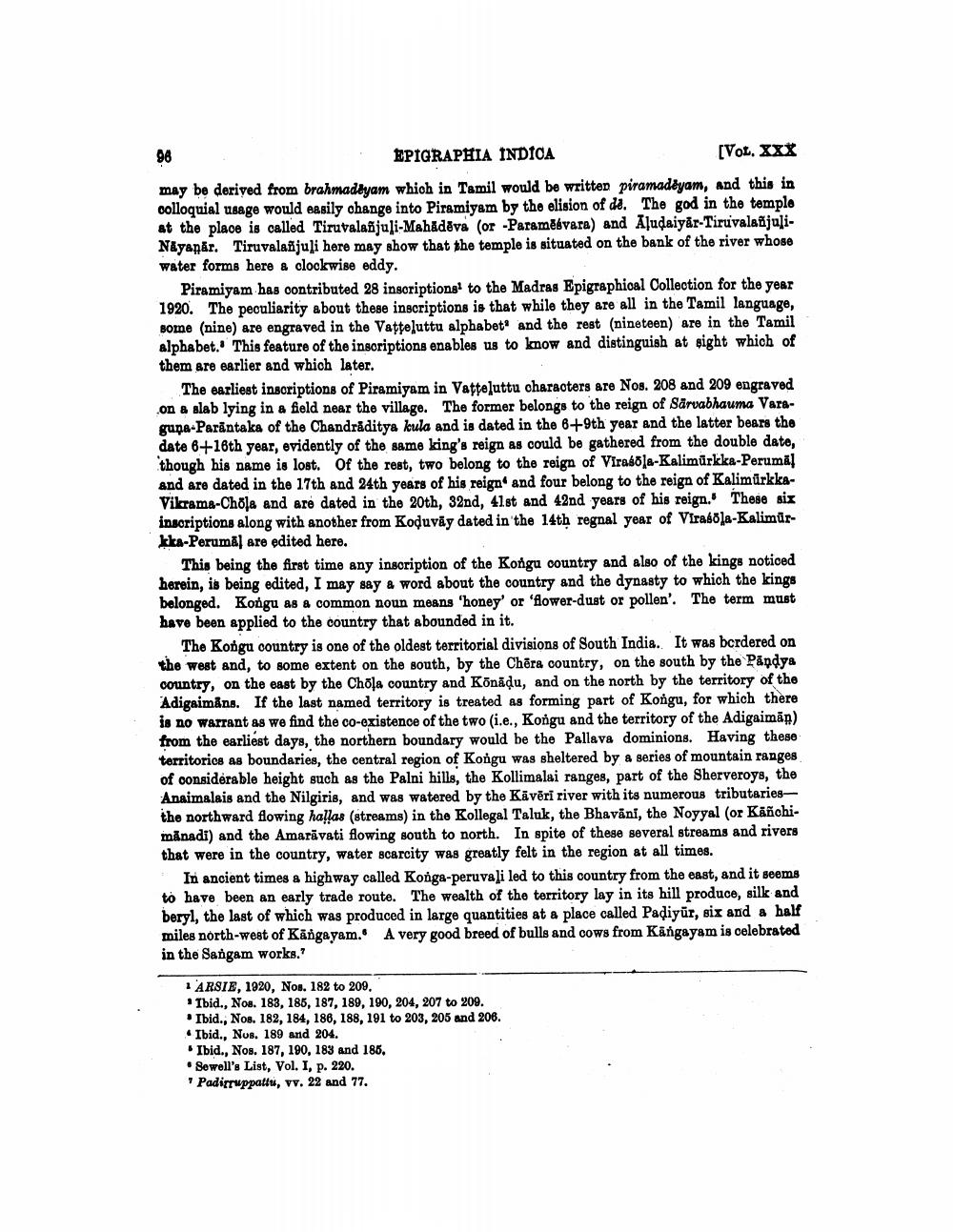________________
EPIGRAPHIA INDICA
[Vot. XXX may be derived from brahmaddyam which in Tamil would be written piramaděyam, and this in colloquial usage would easily change into Piramiyam by the elision of de. The god in the temple at the place is called Tiruvalañjuli-Mahadeva (or -Paramèsvara) and Aludaiyár-TiruvalaõjuliNayanar. Tiruvalañjuli here may show that the temple is situated on the bank of the river whose water forms here & clockwise eddy.
Piramiyam has contributed 28 inscriptions to the Madras Epigraphical Collection for the year 1920. The peculiarity about these inscriptions is that while they are all in the Tamil language, some (nine) are engraved in the Vatteluttu alphabet and the rest (nineteen) are in the Tamil alphabet. This feature of the inscriptions enables us to know and distinguish at sight which of them are earlier and which later.
The earliest inscriptions of Piramiyam in Vatteluttu characters are Nos. 208 and 209 engraved on & slab lying in a field near the village. The former belongs to the reign of Sarvabhauma Varaguna-Parāntaka of the Chandråditya kula and is dated in the 6+9th year and the latter bears the date 6+16th year, evidently of the same king's reign as could be gathered from the double date, though his name is lost. Of the rest, two belong to the reign of Virabola-Kalimūrkka-Peruma! and are dated in the 17th and 24th years of his reign and four belong to the reign of KalimürkkaVikrama-Chola and are dated in the 20th, 32nd, 41.st and 42nd years of his reign. These six inscriptions along with another from Koduvay dated in the 14th regnal year of Virabola-Kalimürkka-Perumā) are edited here.
This being the first time any inscription of the Kongu country and also of the kings noticed herein, is being edited, I may say a word about the country and the dynasty to which the kings belonged. Kongu as a common noun means 'honey' or 'flower-dust or pollen'. The term must have been applied to the country that abounded in it.
The Kongu country is one of the oldest territorial divisions of South India. It was bordered on the west and, to some extent on the south, by the Chēra country, on the south by the Pandya country, on the east by the Chola country and Kõnādu, and on the north by the territory of the Adigaimâns. If the last named territory is treated as forming part of Kongu, for which there is no warrant as we find the co-existence of the two (i.e., Kongu and the territory of the Adigaiman) from the earliest days, the northern boundary would be the Pallava dominions. Having these territorics as boundaries, the central region of Kongu was sheltered by a series of mountain ranges of considerable height such as the Palni hills, the Kollimalai ranges, part of the Sherveroys, the Anaimalais and the Nilgiris, and was watered by the Kāvēri river with its numerous tributariesthe northward flowing haļļas (streams) in the Kollegal Taluk, the Bhavani, the Noyyal (or Kāñchimānadi) and the Amaravati flowing south to north. In spite of these several streams and rivers that were in the country, water scarcity was greatly felt in the region at all times.
In ancient times a highway called Konga-peruvali led to this country from the east, and it seems to have been an early trade route. The wealth of the territory lay in its hill produce, silk and beryl, the last of which was produced in large quantities at a place called Padiyūr, six and a half miles north-west of Kängayam. A very good breed of bulls and cows from Kängayam is celebrated in the Sangam works.?
1 ARSIE, 1920, Nos. 182 to 209. * Ibid., Nos. 183, 185, 187, 189, 190, 204, 207 to 209.
Ibid., Nos. 182, 184, 186, 188, 191 to 203, 205 and 206. • Ibid., Nus. 189 and 204. . Ibid., Nos. 187, 190, 183 and 185, • Sewell's List, Vol. I, p. 220.
Padirruppattu, vv. 22 and 77.




